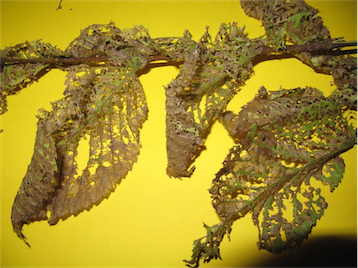Most gardeners are familiar with the pear and cherry tree slug, which skeletonises the leaves, leaving just the veins showing. The Elm Leaf Beetle does the same thing on a bigger scale, but attacking only elm trees.
First spotted in Australia in 1989, it has now spread throughout Victoria and is now in our region.
These beetles can completely defoliate even the largest elms in a short time in late summer and autumn. Elms will sprout new leaves in spring, however the growth of the tree can be affected and may ultimately lead to its demise.
Trunk banding (available at most garden centres) creates a sticky band around the trunk similar to that used on fruit trees and can break the beetle’s cycle. This is done before the descent of significant numbers of larvae, usually around Christmas, so band around the end of December.
Report infestations on trees to Canberra Connect on 132281.
THERE are many fragrance shrubs to give us joy in late autumn and through the winter, especially daphne.Most people are familiar with Daphne odora and the variegated form Daphne odora aureomarginata, which have been in cultivation by the Chinese for several thousand years, although not introduced into the West by early plant hunters until 1771.
However, there are only a few daphne from China compared with the great many varieties from Europe, especially from the Mediterranean, growing from the toe of Italy right up through the Caucasus and Piedmont.
Used to long, hot summers, are well suited to our extremes of climate, more so than the Chinese varieties. Although, there is no doubt that Daphne odora grows well in this area.
ENGLISH author Robin White’s book “Daphnes – A practical guide for gardeners” (Timber Press) is essential reading for daphne lovers. This book lists more than 200 daphnes, many cultivars bred by White.
His speciality is the European daphnes. Daphne x transatlantica “Eternal Fragrance” became available here about two years ago and the garden centres cannot get enough. Now “Spring Pink”, its newly released first cousin, has hit the shelves.
WHEN buying plants, don’t just look at the common name, but read the full name on the label. Some common-name labelling can be misleading.
For example, Correas have been described as “native fuchsias”, whereas in reality they are not even related. A better description would perhaps be “fuchsia like”.
Another example is Edgeworthia papyrifera labelled as “yellow daphne”, is not a daphne, although botanically it belongs to the same family as daphne, namely Thymelaeaceae.
Interestingly this Edgeworthia, more correctly E. chrysanthas is a Chinese shrub that grows to between 1m and 1.5m tall with clusters of fragrant yellow flowers clothed on the outside with white. It is used in Japan for the manufacture of high-class paper for currency. It was introduced to the West in 1845. Despite the misleading common name it is still an attractive shrub.
Jottings…
• With the ground soft after recent rain, it’s a good time to move wrongly placed evergreen shrubs. Trim any broken roots before replanting.
• Hellebores can also be moved at this time. Apply Maxicrop Seaweed Plant Nutrient to encourage new root growth to relocated shrubs.
• Final reminder to move citrus in pots under cover, i.e. under eaves or in carport. In the garden, if not too large, cover with hessian supported by tomato stakes.
• Remove plastic tap watering timers before frost (by the time you read this this may have already happened!).
The post Gardening: March of the deadly beetle appeared first on Canberra CityNews.

